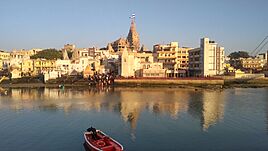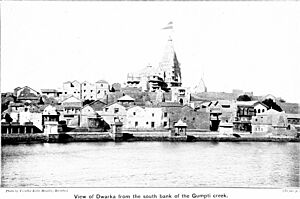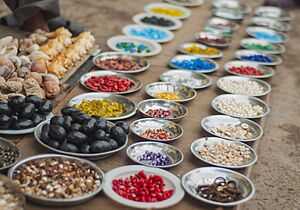Dwarka facts for kids
Quick facts for kids
Dwarka
|
|
|---|---|
|
Town
|
|
|
Clockwise from top: Dwarkadhish Temple, Sudama Setu, Gomti Ghat, Nageshvara Jyotirlinga
|
|
| Country | |
| State | |
| Region | Saurashtra |
| District | Devbhumi Dwarka |
| Founded by | Krishna |
| Government | |
| • Type | Municipality |
| • Body | Dwarka Nagarpalika |
| Elevation | 0 m (0 ft) |
| Population
(2011)
|
|
| • Total | 38,873 |
| Languages | |
| • Official | Gujarati |
| Time zone | UTC+5:30 (IST) |
| PIN |
361335
|
| Vehicle registration | GJ-37 |
| Website | https://devbhumidwarka.nic.in/ |
Dwarka is an ancient and important city located in the Gujarat state of India. It sits on the western coast of the Okhamandal Peninsula, right where the Gomti River meets the Arabian Sea.
Dwarka is very special because it has the famous Dwarkadhish Temple, which is dedicated to Krishna. This temple is one of the four most sacred Hindu pilgrimage sites in India, known as the Chardham. These sites were founded by a wise teacher named Adi Shankaracharya. Dwarka is also one of the seven oldest religious cities in India, called the Sapta Puri.
The city is part of a special "Krishna pilgrimage circuit" that includes other important places like Vrindavan and Mathura. The Indian government has also chosen Dwarka as one of 12 heritage cities to improve its public facilities.
Dwarka has a hot, dry climate, with most of its rain falling in just 16 days. In 2011, about 38,873 people lived there. The biggest festival celebrated in Dwarka is Janmashtami, which honors the birth of Lord Krishna.
Contents
History of Dwarka
Ancient Stories and Legends
Dwarka is thought to be the first capital city of Gujarat. Its name means "gateway." People have also called it "Mokshapuri," "Dwarkamati," and "Dwarkavati" throughout history. The city is mentioned in the ancient Indian epic, the Mahabharata.
According to legend, Lord Krishna made Dwarka his home after defeating his uncle Kamsa in Mathura. This story of Krishna moving to Dwarka is a very important part of the culture of Gujarat. It is also believed that Krishna created Dwarka by reclaiming about 96 square kilometers (37 square miles) of land from the sea.
Archaeologists believe that the first Dwarkadhish Temple was built around 200 BCE. The temple you see today was rebuilt and made larger in the 15th and 16th centuries. Dwarka is also home to one of the four main religious centers, or peeths, set up by Adi Shankaracharya. Because it's a major pilgrimage site, Dwarka has many important temples, including the Rukmini Devi Temple and temples at Gomti Ghat. There is also a lighthouse at the edge of the land.
What Archaeology Tells Us
Archaeologists have explored Dwarka both on land and underwater in the Arabian Sea. The first studies on land in 1963 found many old objects. Later, underwater excavations discovered submerged settlements, a large stone dock, and special triangular stone anchors. These findings suggest that Dwarka was a busy port during the Middle kingdoms of India. It's thought that the ancient port was destroyed by the sea wearing away the coast.
Dwarka is also mentioned in an old copper plate from 574 CE. The nearby island of Bet Dwarka is an important archaeological site from the Late Harappan period, with some findings dating back to 1570 BCE.
Dwarka Through the Ages
In 1473, the Gujarat Sultan Mahmud Begada attacked Dwarka and destroyed its temple. The Jagat Mandir, or Dwarakadhisa temple, was later rebuilt. During a Muslim invasion in 1551, the idol of Dwarkadhish was moved to the island of Bet Dwarka for safety.
During the Indian rebellion of 1857, Dwarka was controlled by the Gaekwad of Baroda state. There was a war in 1858 between local people called Vaghers and the British. The Vaghers won at first, but later, a combined force of British and other princely state troops defeated them in 1859. During these fights, the temples in Dwarka and Bet Dwarka were damaged and looted. Later, the temples were restored. In 1861, Maharaja Khanderao and the British renovated the Dwarakadheesh Temple. In 1958, Maharaja Gaikwad of Baroda added a golden top to the temple. Since 1960, the Indian government has taken care of the temple.
The Sudama Setu, a bridge over the Gomti River that connects Dwarka to Panchkui island, was opened in 2016.
Geography and Climate
Dwarka's Location
Dwarka is located at the mouth of the Gulf of Kutch, on the western side of the Okhamandal Peninsula. It sits on the right bank of the Gomti River, which starts about 10 kilometers (6 miles) to the east. Dwarka is now part of the new Devbhoomi Dwarka district, facing the Arabian Sea. The Gomti River used to be a harbor until the 1800s.
Dwarka's Weather
Dwarka has a hot, dry climate. Most of its rain, about 404 millimeters (16 inches), falls during a short rainy season of about 16 days, usually from June to September. However, the amount of rain can change a lot from year to year. For example, in 1987, it rained only 15 millimeters (0.6 inches), but in 2010, it rained 1288 millimeters (50.7 inches)!
The average high temperature is about 30°C (86°F), but it can get as hot as 42.7°C (108.9°F). The average low temperature is about 23.6°C (74.5°F), but it can drop to 6.1°C (43°F). The air is usually quite humid, around 72%.
| Climate data for Dwarka (1981-2010, extremes 1901–present) | |||||||||||||
|---|---|---|---|---|---|---|---|---|---|---|---|---|---|
| Month | Jan | Feb | Mar | Apr | May | Jun | Jul | Aug | Sep | Oct | Nov | Dec | Year |
| Record high °C (°F) | 34.0 (93.2) |
36.5 (97.7) |
38.8 (101.8) |
41.1 (106.0) |
42.7 (108.9) |
39.5 (103.1) |
36.4 (97.5) |
33.8 (92.8) |
39.4 (102.9) |
40.0 (104.0) |
37.6 (99.7) |
35.2 (95.4) |
42.7 (108.9) |
| Mean daily maximum °C (°F) | 26.4 (79.5) |
27.2 (81.0) |
28.7 (83.7) |
30.3 (86.5) |
31.8 (89.2) |
32.4 (90.3) |
31.1 (88.0) |
30.0 (86.0) |
30.7 (87.3) |
31.7 (89.1) |
31.6 (88.9) |
28.4 (83.1) |
30.0 (86.0) |
| Mean daily minimum °C (°F) | 16.5 (61.7) |
18.7 (65.7) |
22.3 (72.1) |
25.2 (77.4) |
27.4 (81.3) |
28.4 (83.1) |
27.6 (81.7) |
26.4 (79.5) |
26.1 (79.0) |
24.9 (76.8) |
21.7 (71.1) |
17.9 (64.2) |
23.6 (74.5) |
| Record low °C (°F) | 6.1 (43.0) |
8.3 (46.9) |
7.8 (46.0) |
17.2 (63.0) |
20.0 (68.0) |
22.0 (71.6) |
21.3 (70.3) |
20.6 (69.1) |
21.8 (71.2) |
16.7 (62.1) |
12.2 (54.0) |
8.3 (46.9) |
6.1 (43.0) |
| Average rainfall mm (inches) | 1.1 (0.04) |
1.1 (0.04) |
0.2 (0.01) |
0.0 (0.0) |
0.0 (0.0) |
65.7 (2.59) |
171.7 (6.76) |
109.3 (4.30) |
48.5 (1.91) |
3.5 (0.14) |
2.2 (0.09) |
0.4 (0.02) |
403.7 (15.89) |
| Average rainy days | 0.1 | 0.2 | 0.0 | 0.0 | 0.1 | 2.3 | 6.1 | 4.9 | 1.7 | 0.5 | 0.0 | 0.0 | 15.9 |
| Average relative humidity (%) (at 17:30 IST) | 53 | 62 | 73 | 77 | 79 | 79 | 83 | 83 | 80 | 72 | 56 | 49 | 70 |
| Source: India Meteorological Department | |||||||||||||
People and Economy
Population and Education
In 2011, Dwarka had a population of 38,873 people. There were 20,306 males and 18,567 females. The city's literacy rate (people who can read and write) was about 75.94%, which is a little lower than India's national average. More males (83%) could read than females (68.27%). About 11.98% of the population was under six years old.
The Sharda Peeth Vidya Sabha is an educational group that runs an arts college in Dwarka. There are also high schools like N.D.H. High School and P.V.M Girls' High School.
How Dwarka Makes Money
Most of Dwarka's money comes from tourism, especially from pilgrims visiting the holy sites. The city also produces farm goods like millets, ghee (clarified butter), oilseeds, and salt, which are sent out from its port.
In 2011, a big plan was suggested to invest money to improve Dwarka and build a bridge connecting it to Okha and Bet Dwarka. There's also a wind farm near Dwarka that generates 39.2 megawatts of power. Dwarka's main industrial activity is making cement.
Things to See and Do in Dwarka
Dwarka is famous for its many temples and as a spiritual center, attracting many visitors every year.
Underwater Tourism in Dwarka
In December 2023, the government of Gujarat announced plans for India's first submarine-based underwater tourism in Dwarka. This exciting project, expected to start by October 2024, will let tourists explore the amazing marine life around Dwarka. Submarines will take 24 tourists, along with pilots and crew, down to 100 meters (328 feet) below the sea to see the underwater world.
Famous Temples of Dwarka
Dwarka is considered a holy city and is well-known for its temples. The Dwarakadhisa Temple, also called Jagat Mandir, is a very important Vaishnava temple in the heart of Dwarka. It is believed to be 2,500 years old, though the current temple building is from the 16th century. It is a five-story building supported by 72 pillars. The temple's tall spire reaches 78 meters (256 feet) high, and a very large flag with sun and moon symbols flies on top. Inside, the main deity is Dwarkadeesh, a four-armed form of Vishnu.
The Dwarakadhisa Temple is also home to the Dvaraka Pitha, one of the four main religious centers established by Adi Shankaracharya.
Gomti Ghat has steps leading to the Gomti River, where pilgrims take a holy dip before visiting the Dwarakadish temple. There are small shrines here dedicated to the Sea God, Saraswati, and Lakshmi. Other important temples at the ghat include the Samudra Narayana temple and the Chakra Narayana temple.
The Rukmini Devi Temple, dedicated to Rukmini, Lord Krishna's main queen, is about 2 kilometers (1.2 miles) from Dwarka. This temple is also said to be 2,500 years old, but its current structure is from the 12th century. It is beautifully carved with sculptures of gods and goddesses.
Nageshvara Jyotirlinga Temple
The ancient Nageshvara Jyotirlinga temple is a sacred Shiva temple, located just 16 kilometers (10 miles) from Dwarkadhish Temple. It is one of the 12 special Jyotirlingas (meaning "pillars of light") in India, with the main deity located in an underground chamber.
Lighthouse and Lakes
There is a lighthouse at Dwarka Point that offers amazing views of the town. The light is 70 feet (21 meters) above sea level and can be seen from 10 miles (16 kilometers) away. The lighthouse tower is 40 feet (12 meters) tall and uses solar power.
There is a lake called Gopi Talab in the western part of Dwarka. Another similar lake, known for Gopi Chandan (a special fragrant mud), is found in Bet Dwarka. This mud is used by devout Hindus on their foreheads as a symbol of holiness.
Bet Dwarka Island
Bet Dwarka is an island in the Arabian Sea, just off the coast of Dwarka. It is believed to be Lord Krishna's original home. In ancient times, Bet Dwarka was the main port before the Okha port was developed in Dwarka. The temple here is said to have been built by the religious teacher Vallabhacharya. People traditionally offer rice to the deity here, as it is believed that Krishna's childhood friend Sudama offered him rice.
There are also smaller shrines on Bet Dwarka dedicated to Shiva, Vishnu, Hanuman, and Devi. According to a legend, Vishnu defeated the demon Shankhasura on this island. The Sudarshan Setu, a bridge, now connects the mainland to Bet Dwarka, making it easier to visit the island.
The Hanuman Dandi temple is another important temple on Bet Dwarka, about 6 kilometers (3.7 miles) from the main Dwarkadhish Temple on the island. This temple has many images of Hanuman and his son Makardhwaja.
Shivrajpur Beach
Shivrajpur Beach is about 14.5 kilometers (9 miles) from Dwarka Railway Station. It is one of only eight Indian beaches to receive the special Blue Flag beach certification, which means it meets high standards for environmental quality, safety, and services.
Culture and Celebrations
Festivals and Traditions
Janmashtami is the most important festival in Dwarka, celebrated with great excitement in August or September. It marks the birth of Lord Krishna. The festival includes night-long celebrations with devotional songs (Bhajans) and speeches. At midnight, people reenact Krishna's childhood, performing traditional dances like Garba and Raas dances. During this time, boys form human pyramids, and a young boy dressed as Krishna climbs to the top to break a pot filled with butter, just like Krishna playfully did with the gopis (cowherd girls). This event is also known as "Dahi Handi".
Getting Around Dwarka
Dwarka is well-connected by roads, railways, and air to other cities across India.
Train Travel
Dwarka railway station is a busy train station that connects the city to many major cities in Gujarat and other parts of India. There are weekly trains to places like Guwahati, Rameswaram, Puri, and Kolkata. Daily trains connect Dwarka to major cities in Gujarat such as Ahmedabad, Jamnagar, and Rajkot.
Air Travel
The closest airport to Dwarka is Jamnagar Airport, which is about 131 kilometers (81 miles) away. This airport has daily direct flights to Mumbai and flights three times a week to Hyderabad and Bengaluru.
Road Travel
Dwarka is about 217 kilometers (135 miles) from Rajkot, 235 kilometers (146 miles) from Somnath, and 378 kilometers (235 miles) from Ahmedabad. You can easily reach Dwarka by road from these and other cities.
See also
 In Spanish: Dwarka para niños
In Spanish: Dwarka para niños




















